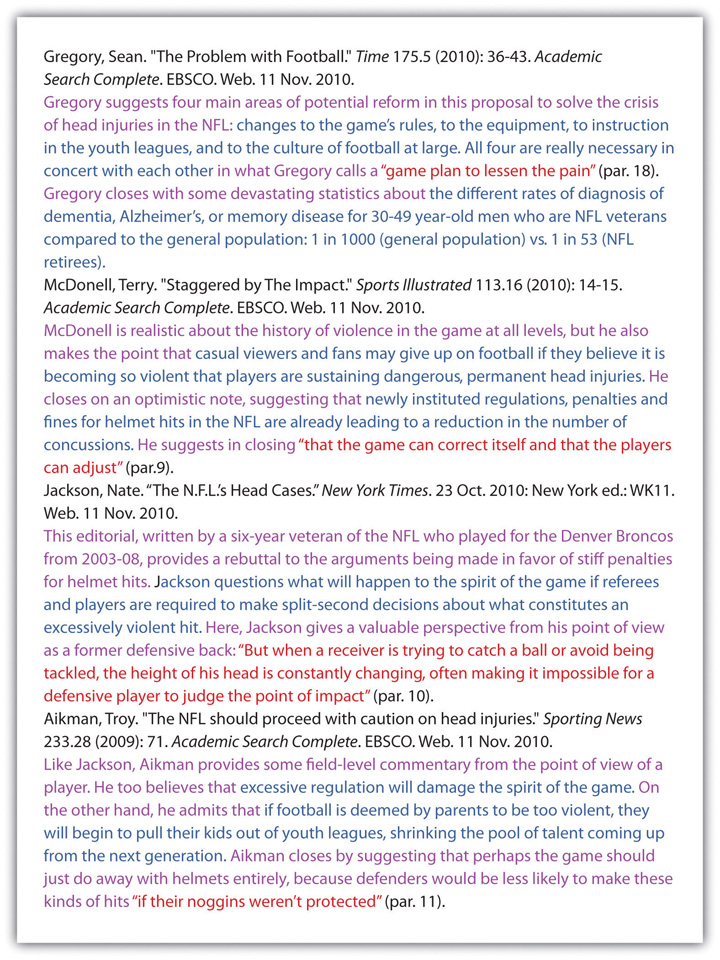7.8 Creating an Annotated Bibliography
Learning Objectives
- Know how to deal with a new source by bookmarking it and creating an annotated bibliography for it.
- Understand the information you need to create a citation and annotated bibliography.
- Know how to use an annotated bibliography as a tool for probing research questions in more depth.
To make the best use of your research time, thoroughly read each source that is clearly relevant and document all the pieces you might use from it so that you will have a good chance of not having to revisit it. But just in case, take care to bookmark the site (and additionally save it to a folder set up for your research project) so you can easily return to it later and collect the needed information.
Your research log should include an annotated bibliography of the sources you plan to use. Each entry should include the following elements:
- The complete citation information (in the format the assignment requires)
- A summary or paraphrase of the contents of the source in your words
- The direct quotations you may end up using (with page or paragraph numbers)
- Additional strategy notes about how you plan to use the source (For more on quoting, summarizing, and paraphrasing, see Section 7.7 "Making Ethical and Effective Choices".)
For the citation, gather the following components:
- Name of author, editor, sponsoring organization, discussion group, or list
- Title of article or subject line of discussion
- Title of journal or site that has published the article
- Version number or issue number, if applicable
- Date of publication
- Date you accessed the site
If a source does not appear to be as relevant as you initially thought it would be, document the situation in your log and move on. Don’t try to jam it into the essay just because you spent time tracking it down. Good researchers and good writers know they’ll encounter a few dead ends and bad leads.
Here are a couple of entries Antonio makes in his annotated bibliography for an essay he is writing on head injuries in football. Using the same search terms (“helmets,” “NFL,” and “head injuries”), a search of Academic Search Complete in his college library nets him entries 1, 2, and 4, and a search on Google nets him entry 3. Drawing from the color-coding suggestion in Section 7.6 "Taking Notes", Antonio distinguishes between direct quotation (red), paraphrase (blue) and summary (purple), by using different font colors for each.
Key Takeaways
- Create a folder and place a bookmark for each new online source in it so you can easily return to it. Also, create a citation for each source when you first encounter it.
- When citing an online source, find the following pieces of information: name of author, editor, or sponsoring organization; title of article; title of journal or site that has published the article; version or issue number; and date of publication and access date.
Exercises
- Choose a research topic of interest to you. Find a related website and find the following pieces of information: name of author, editor, or sponsoring organization; title of article; title of journal or site that has published the article; version or issue number; date of publication or access date.
- Choose a research topic of interest to you. Find a related online blog.
- Choose a research topic of interest to you and set up a related RSS feed.
- Choose a research topic of interest to you. Find a related government site.
- Choose a research topic of interest to you. Online, find a related photo, video, and table.
- With your writing group sharing a couple of computers, amass several sources for Jacoba’s essay on Social Security and write up an annotated bibliography.
- Using Antonio’s essay idea on helmet hits in the NFL, draw up two statements of purpose that differ from each other in at least three of the six concerns (voice, audience, message, tone, attitude, or reception).
